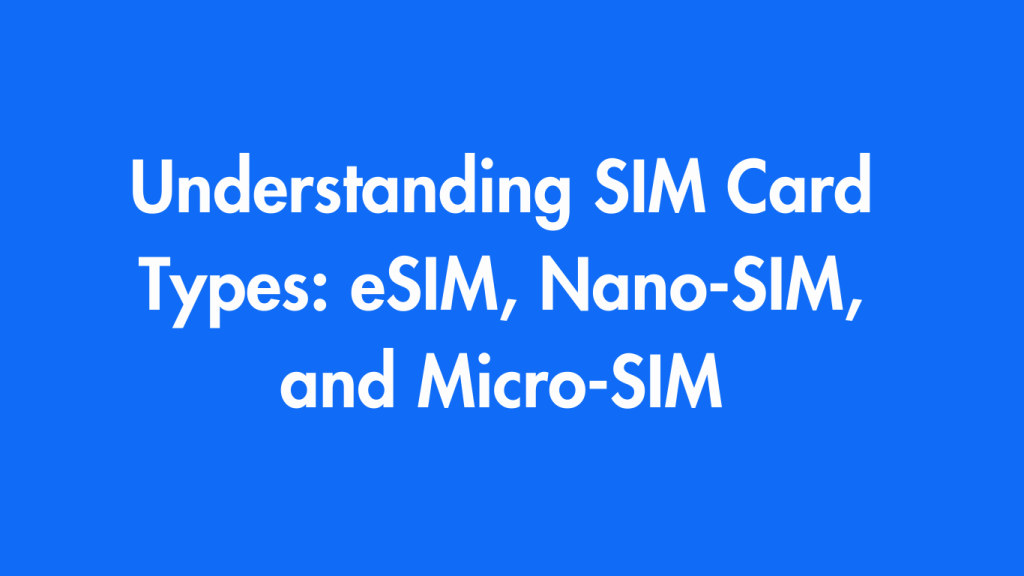SIM cards are essential for staying connected in the digital world of today. SIM cards are used to facilitate mobile communication. They can be used for everything from making phone calls to accessing data. SIMs have changed over time. They now come in a variety of sizes and functions. The most popular are the eSIM (electronic SIM), Nano-SIM (nano-SIM) and Micro-SIM.
This guide will explain the differences between these SIM cards, their use and how they can meet the needs of modern devices.
What Is a SIM Card?
It’s important to understand what a SIM is before exploring the different types of SIM cards. A SIM card, or Subscriber Identity Module (SIM), stores the data necessary to connect to mobile networks.
This includes your phone number, your carrier’s details, encryption key and phone encryption keys.
SIM cards are required to authenticate your device and ensure that you can send text messages, make calls and use mobile data.
Evolution of SIM cards
SIM cards have been modified many times since their introduction in the 1990s. The most significant change has been in size. Initially, SIM cards were bulky and large. As technology improved, however, the demand for smaller, more efficient components increased, leading to Micro-SIM and Nano-SIM technologies.
Types of SIM Cards
There are different types of sim cards. we will learn the types and how they works.
1. Standard SIM (Mini SIM) Cards
Standard SIM Cards, also known as Mini-SIMs or Standard SIMs, were the first SIM cards used in mobile phone. Early devices used the 25mm x15mm SIM card. In order to conserve space, many smartphones today opt for smaller designs. Standard SIMs are now mostly outdated.
Use Cases:
- Devices that require older SIM technology
- Early mobile phones (pre-2010)
2. Micro-SIM
Micro-SIM cards were introduced in 2010 with the release of iPhone 4. Measuring 15mm x 12mm, this smaller-than-standard SIM retains all the same functionality while taking up less space inside smartphones – becoming incredibly popular early 2010s and used widely across different models.
Use Cases:
- Smartphones released between 2010 and 2015 (e.g., iPhone 4, Samsung Galaxy S3)
- Tablets with cellular connectivity
As mobile phone use increased exponentially, micro-SIM cards were especially important. They allowed more efficient internal space usage while still remaining compatible with larger SIM slots via adapters.
3. Nano-SIM
Nano-SIM cards were first introduced in 2012. They are the smallest SIM cards on the market, measuring only 12.3mm x 8.8mm. However, they still hold all the information of traditional SIMs or micro SIMs. Since its debut on the iPhone 5, this technology has been widely adopted by modern smartphones.
Nano-SIMs are smaller than traditional SIM cards, allowing device manufacturers to conserve space by reducing the number of batteries and other components.
Use Case:
- Smartwatches with cellular capabilities
- Most modern smartphones (e.g., iPhone 5 and later, Samsung Galaxy S6 and later)
- Cellular-enabled tablets (e.g., iPads with cellular connectivity)
4. eSIM
The latest in SIM card technology is an Embedded SIM (or “eSIM”). The traditional SIMs are physical chips you insert into your device. An eSIM, however, is embedded directly into the hardware of the device. This allows users to easily switch between networks without having to physically change their SIM card. The eSIM has multiple carrier profiles to make switching easy without having to physically change it.
eSIM offers users greater flexibility and convenience, allowing them to switch carriers or activate quickly without having to insert a new SIM card. The compact size makes it ideal for devices with limited space, such as smartwatches and IoT devices.
Use Cases:
- IoT (Internet of Things) devices like connected cars and home security systems
- Smartphones with eSIM support (e.g., iPhone XS, Google Pixel 3, Samsung Galaxy S20)
- Smartwatches with cellular connectivity (e.g., Apple Watch, Samsung Galaxy Watch)
The advantages and applications of each SIM type
1. Micro-SIM Technology Advantages
- Better than standard SIM: Micro-SIM has a smaller form factor than its counterpart and can be used in slimmer devices.
- Compatible Devices: Micro-SIM is still used in older devices which haven’t yet upgraded to Nano-SIM, eSIM or eSIM.
- Adapters: There are adapters available: You can use Micro-SIMs in older SIM slots. This allows you to be flexible.
2. Nano-SIM: Benefits and Advantages
- Compact Size: Nano-SIMs’ small size allows manufacturers to include other components such as larger sensors or batteries.
- Nano-SIM Cards are widely used: They are compatible with many devices and one of the most commonly used SIM card types.
- Easy to use: Like other physical SIM cards, the Nano-SIM can be easily swapped between devices.
3. Benefits of eSIM
- No physical card required: The eSIM eliminates the physical SIM card, making it easier than ever to switch carriers.
- Supports multiple carriers: With eSIM users can store and switch between multiple carrier profiles in one device. This is a great solution for frequent travellers or those with multiple phone numbers that need to be able to dial home.
- Space Savings: Because eSIMs are integrated directly into devices they allow manufacturers to create even slimmer devices and add features that they’ve always wanted.
Differentiating between eSIM cards and physical SIM cards
The main difference between traditional SIM cards and eSIM (Virtual SIM) is that the eSIM does not require a physical card to function. This provides several advantages:
- Convenience: Electronic SIMs allow users to activate mobile plans without having to visit a carrier’s store or receive a physical SIM. By scanning a QR Code or using an App, users can activate their mobile plan quickly and easily.
- Multiple Profiles: Electronic SIMs allow for multiple profiles, which makes switching between carriers and plans easier than physical SIM cards. This feature is especially useful for people who travel or need separate numbers for work and personal.
- Environmentally Friendly: Electronic SIMs are more environmentally friendly because they eliminate the need for plastic SIM cards. This reduces waste generated by SIM card disposal.
- Security: Due to their integration into devices, electronic SIMs offer a more secure option than physical SIMs. They are also harder to remove. This reduces the risk of loss or theft.
SIM Card Sizes and Adapters
Adapters are needed to accommodate the different sizes of SIM cards, from Standard SIMs up to Micro-SIMs or Nano-SIMs. These adapters enable Nano-SIM and Micro-SIM cards fit into larger SIM slot – for example, a Nano-SIM card can be put into an adapter for Micro-SIMs.
The adapters allow you to safely use one SIM across different devices that have different SIM slots. However, they must be handled with care when inserting or removing them. Improper insertion could damage the slot or card.
Transition to eSIM Technology
The future of mobile connectivity is the transition to eSIM. Although physical SIM cards are still widely used, they have steadily increased in popularity among premium smartphones and smart watches. This allows consumers to manage multiple carriers from their device while also increasing the manufacturers’ competitiveness.
- Carriers adopting eSIM: Many mobile carriers now support eSIM, allowing customers to easily switch plans or carriers without having to use physical cards.
- Device compatibility: While eSIM technology continues to evolve, many new phones, including iPhones, Google Pixels, and Samsung Galaxys, already support both technologies, allowing users to get the most out of both technologies.
Future of SIM cards: eSIM & Beyond
With the advancement of mobile technology, SIM cards could eventually become virtual experiences via eSIM and even more recent innovations such as iSIM. iSIM takes it a step farther by integrating its functionality directly into a smartphone’s processor to maximize space and power efficiency.
Benefits of a Integrated SIM (iSIM)
- With iSIM, you can further reduce the size of your device by eliminating the need for multiple SIM modules.
- iSIMs are more power efficient than eSIMs and therefore suitable for IoT devices that require low power.
Although iSIM will take some time to reach the mainstream, this is a significant step for mobile connectivity.
Conclusion
The evolution of SIM card sizes from Standard SIM, Micro-SIM to Nano-SIM then eSIM reflects the evolving needs of mobile technologies. As more devices adopt eSIM, users will benefit from greater flexibility, convenience, and space-saving design. Understanding the differences between SIM card types allows you to make more informed decisions when choosing devices or plans. This will help you stay on budget and remain cost-efficient. Understanding these differences allows you to make better decisions when choosing devices or plans.


